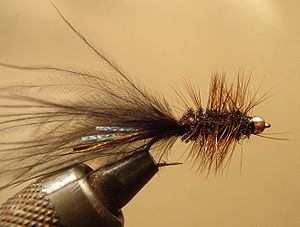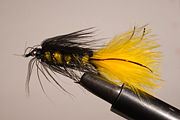
Woolly Bugger
Encyclopedia

Artificial fly
An artificial fly or fly lure is a type of fishing lure, usually used in the sport of fly fishing . In general, artificial flies are the bait which fly fishers present to their target species of fish while fly fishing...
commonly categorized as a wet fly or streamer and is fished under the water surface. It is a popular and widely used pattern for both freshwater and saltwater game fish and is generally listed as one of the top patterns to have in any fly box. John Gierach
John Gierach
John Gierach is an American author and freelance writer who formerly resided on the St. Vrain River in Lyons, Colorado and now lives in Larimer County, Colorado. His books' themes are based on his various fly fishing adventures, some of which take place with his friend, A.K. Best...
, a noted Fly Fishing
Fly fishing
Fly fishing is an angling method in which an artificial 'fly' is used to catch fish. The fly is cast using a fly rod, reel, and specialized weighted line. Casting a nearly weightless fly or 'lure' requires casting techniques significantly different from other forms of casting...
writer discussed the Woolly Bugger first in his chapter on streamers in Good Flies.. Woolly Buggers are typically fished in streams, rivers, ponds, lakes, and tidal flats. Today, Woolly Buggers are tied in a wide variety of styles and colors to imitate a wide range of game fish prey.
Origin
Although the original Woolly Bugger pattern was believed to have been created by Russell Blessing, Pennsylvania Fly Tyer as early as 1967 to resemble a hellgrammiteHellgrammite
Hellgrammite can be:*an insect, the aquatic larva of the dobsonfly.*the DC comics character Hellgrammite.The aquatic larvae hellgramite has large pincers and can be found under rocks in fresh water....
, or Dobsonfly
Dobsonfly
A Dobsonfly is any insect of the subfamily Corydalinae, part of the megalopteran family Corydalidae. There are over 220 species of dobsonflies. Dobsonflies are found throughout the Americas and Asia, as well as South Africa...
nymph, its precise origin is unknown, but is clearly an evolution of the Wooly Worm
Woolly Worm (imitation)
The Woolly Worm is an artificial fly commonly categorized as a wet fly or nymph and is fished under the water surface. It is a popular pattern for freshwater game fish and was a very popular fly in the 1950s – 1970s in the west. Charles Brooks in Nymph Fishing for Larger Trout recommends the...
fly, , which itself is a variation--intentional or not--of the British palmer fly, which dates back to Walton and beyond.
Imitates

Materials
The Woolly Bugger fly is constructed with a marabouMarabou Stork
The Marabou Stork, Leptoptilos crumeniferus, is a large wading bird in the stork family Ciconiidae. It breeds in Africa south of the Sahara, occurring in both wet and arid habitats, often near human habitation, especially waste tips...
tail (with or with out some sort of flashy material in the tail, a chenille or fur body, and a hackle
Hackle
The hackle is a clipped feather plume that is attached to a military headdress.In the British Army and the armies of some Commonwealth countries the hackle is worn by some infantry regiments, especially those designated as fusilier regiments and those with Scottish and Northern Irish origins. The...
palmered from the tail to the head of the fly. Tying the pattern with a rib helps protect the palmer hackle. The underbody may be weighted with lead wire. Popular colors are olive, brown, and black for freshwater use. Brighter colors and combinations of colors are especially popular for steelhead, salmon and saltwater use.

